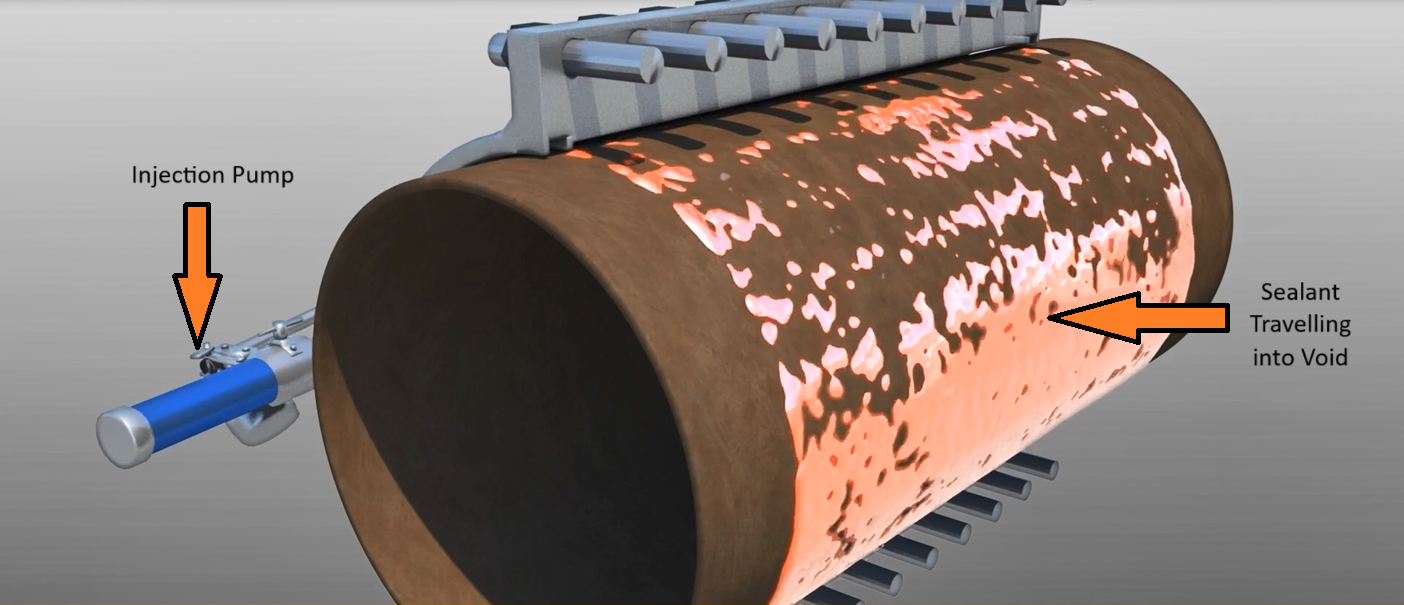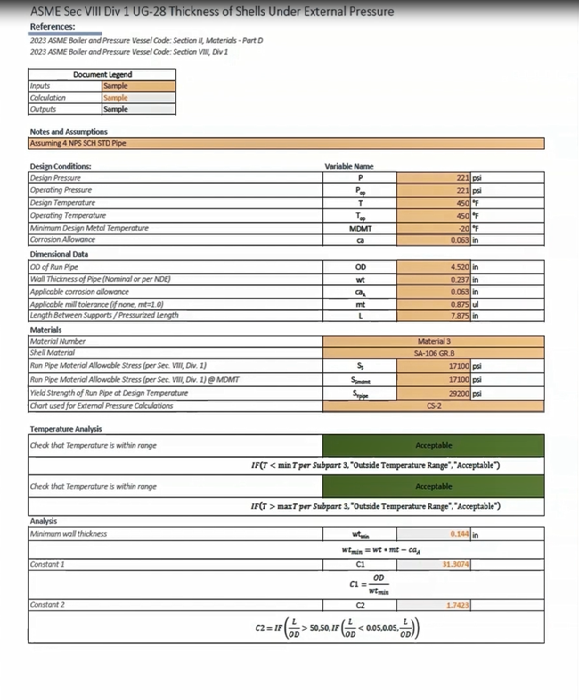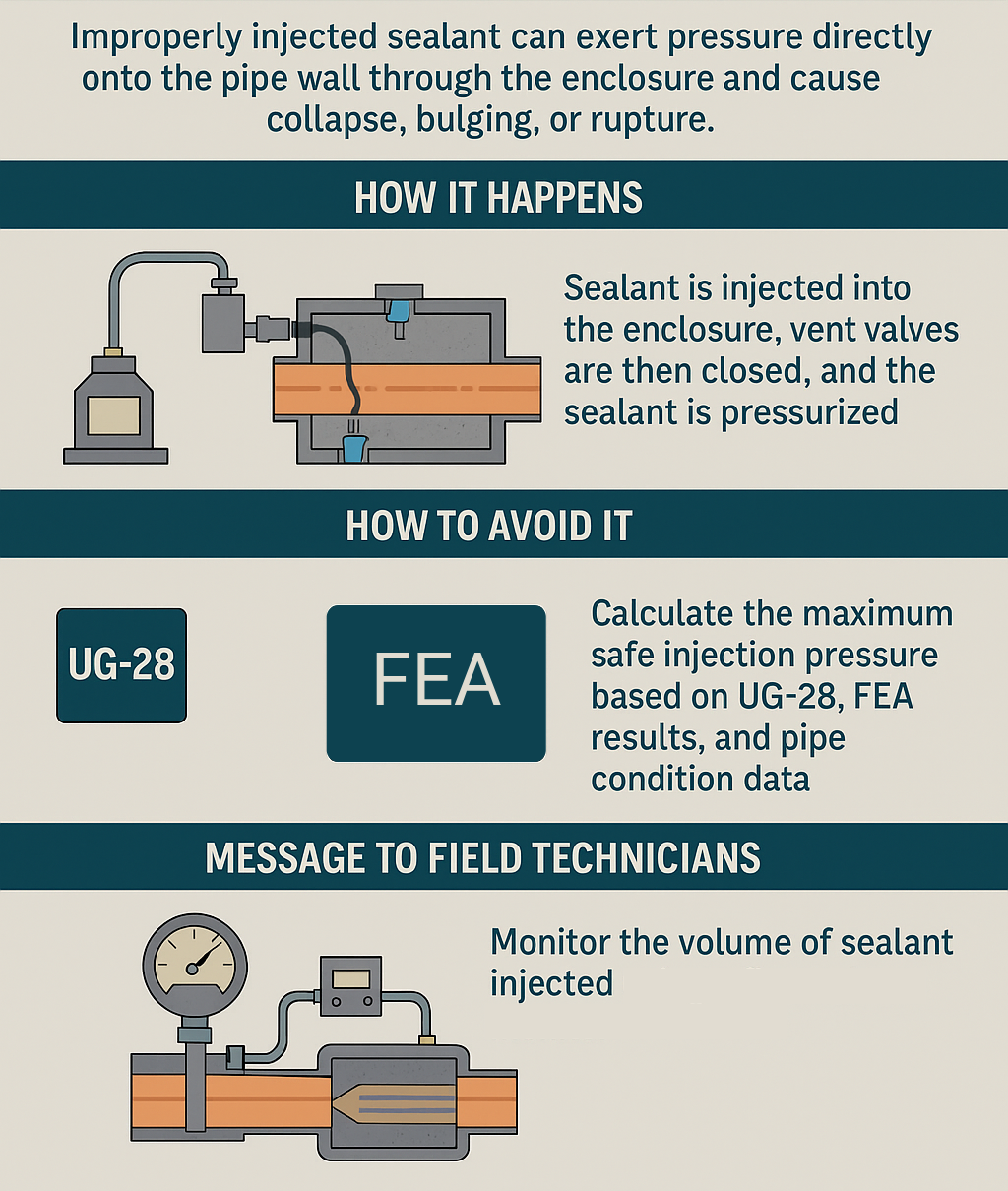The Technician’s Nightmare: When Leak Repairs Cause Pipe Failure
You fix the leak, but suddenly, the pipe fails. What went wrong - and how do you stop it from happening again?
Improper injection during leak repair can introduce dangerous external pressures that the pipe can not handle. This hidden risk isn’t just theoretical—it’s happened before. Here’s how these failures occur, and how smart design and field practices can prevent them.
Understanding the Risk: How External Pressure Builds Up
When using enclosures for leak repair, technicians often deploy a void fill seal. This involves injecting a sealant into the enclosure using a pump, which forces the sealant into the cavity between the enclosure and the piping. Typically, the injection pump is connected to one port, while the other injection valves stay open to act as vents. This setup allows air to be displaced without pressurizing the pipe during the bulk of the injection process — which is critical. However, once all injection ports are sealed, the system transitions from passive filling to active pressurization—placing force directly on the pipe wall. At this point, the technician may pressurize the sealant to ensure complete void filling and proper compression — but this pressurization translates directly into external pressure on the pipe wall.
Injecting Sealant into Void Fill
When Is External Pressure a Problem?
In many cases, pipes can withstand this pressure without issue. But when dealing with pipe wall thinning, either general or local, even moderate pressure can be dangerous. Potential failure modes include:
Pipe collapse
Wall bulging or deformation
In worst-case scenarios: a rupture of the pipe shell
Engineering Controls: Calculating Safe Injection Pressure
To manage this risk, engineers must define a maximum allowable external pressure for the pipe. Here’s how we do it:
1. UG-28 External Pressure Calculations
We start with the ASME UG-28 code to calculate the collapse pressure — the maximum external pressure a pipe can handle. This value becomes our upper injection pressure limit, which is communicated to field technicians.
2. FEA (Finite Element Analysis)
When UG-28 results are overly conservative or impractical, we perform a Finite Element Analysis (FEA). FEA simulates the real-world stress distribution and pipe deformation under pressure, especially when local thinning or defects are involved. This gives us the most accurate estimate of the true pipe wall stresses.
IMPORTANT NOTE!
These calculations are only as reliable as the input data. That’s why it’s critical that end users provide accurate Non-Destructive Examination (NDE) reports. Better data = safer, more realistic pressure limits.
Field Practices: The Technician’s Role in Preventing Damage
Even with thorough engineering oversight, field technicians are the first line of defense against unintended pipe damage.
They must follow approved injection procedures and actively Monitor the Injection Volume. With the help of modern 3D scanning technology, the void volume can now be very accurately calculated so the technicians can trust the numbers provided by engineering. If the technician observes that more sealant is entering the enclosure than expected, it could signal:
Unexpected pipe deformation
An issue with sealant routing or void volume assumptions
This is a critical stop point — technicians should immediately halt the injection and request reevaluation to prevent damage.
🛑 Pro Tip: Take only the calculated sealant volume to the job site—leave the excess in the truck. If you run out, you’re less likely to over-inject.
Final Thoughts: Solving One Problem Shouldn’t Create Another
Enclosures are great tools for in-place industrial leak repair — but they must be handled with care. The risk of external pressure damage is real, particularly in vulnerable piping .
By combining:
Accurate engineering pressure limits
Vigilant field monitoring
Clear communication between engineers, technicians, and end users
…we can keep a simple fix from becoming a catastrophic failure.
If you found this information useful and want to learn more about advanced leak repair methods, don’t forget to subscribe to our channel or join our mailing list. We share new insights and tutorials regularly—stay ahead of your maintenance challenges by staying informed.





